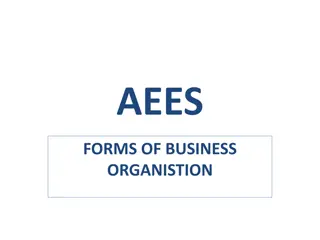Understanding the Three Types of Business Organizations
Explore the characteristics and benefits of sole proprietorships, partnerships, and corporations in the realm of business. Learn about the advantages and challenges of each type, from sole ownership to shared decision-making and corporate structures, along with considerations such as liability, taxation, and financing options.
Download Presentation

Please find below an Image/Link to download the presentation.
The content on the website is provided AS IS for your information and personal use only. It may not be sold, licensed, or shared on other websites without obtaining consent from the author. Download presentation by click this link. If you encounter any issues during the download, it is possible that the publisher has removed the file from their server.
E N D
Presentation Transcript
The Three Types of Business Organizations Three Types of Business Organizations
Sole Proprietorship One owner Tend to be small with no employees Partnership Two or more owners Tend to be small with few, if any, employees Corporation Legal entity that is similar to an individual in the eyes of the law May be large or small, with few or many employees Three Types of Business Organizations
Benefits One person Receives all benefits, profits and income Easy to start and easy to close down Costs Responsible for all decisions and all debts Unlimited liability Difficult to get start-up or expansion financing Income/profits taxed at personal income rates, not business rates Three Types of Business Organizations
Benefits Shared decision-making Can rely on partner s expertise Relatively easy to start Costs May have differences of opinions or disagreements Must decide what to do when one person wants to leave or close down Unlimited liability Difficult to get start-up or expansion financing Income/profit taxed at personal income rates, not business rates Three Types of Business Organizations
Benefits Legal entity that is held responsible for its decisions Ownership is separate and apart from the owner/shareholders Managed by a board of directors Owners/shareholders have limited liability Can be easier to get start-up and expansion financing Considered an individual and pays its own taxes at corporate tax rates Costs Requires legal advice and fees to establish/maintain May be subject to more paperwork and state/federal regulations May have managers with absentee ownership Three Types of Business Organizations
Publicly-held Shares sold over stock exchange to members of the general public Required to file quarterly report with SEC Information shared with shareholders and general public Privately-held Shares not traded over stock exchange; often owned by founder, family members, management or private investors No reports required Information not shared with general public Three Types of Business Organizations
Definition: a company's legal financial debts or other obligations resulting from its daily business operations Unlimited Liability: Sole Proprietor and Partnership Individuals are held responsible for all business activities and must pay any debts or obligations of the business Individuals can be sued and possibly lose personal assets to cover those debts Limited Liability: Corporation The corporation itself is held responsible for all business activities and any debts or obligations. Individual shareholders loss is limited to the amount of money invested in the corporation Three Types of Business Organizations
Definition: Ability to borrow money to start or expand a business Limited Options: Sole Proprietor and Partnership Relies more on individual/personal assets Often financed using credit cards, personal loans or personal savings More Options: Corporation Can sell more stock to raise funds if needed Can borrow money based on its own assets, not those of the owners Three Types of Business Organizations
Taxes: Tax rates and deductions vary for personal income tax and corporate/business income tax at both the state and federal levels Sole Proprietor and Partnership Income/profits taxed as personal income Limited deductions for business expenses Corporations Income/profits taxes as corporate/business income Increased options for deducting business expenses, including employee benefits Three Types of Business Organizations
Each type of business organization has benefits and costs While most businesses in the U.S. would be classified a sole proprietorship , they tend to be small, homebased businesses with limited services and sales The vast majority of business sales and business activity is produced by corporations Corporations may be publicly or privately-held Liability, financing and taxes are key factors in deciding which business organization is best Three Types of Business Organizations

















































